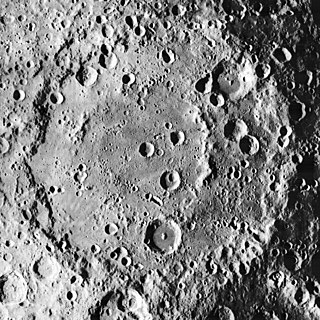 Lunar Orbiter 1 image | |
| Coordinates | 14°12′S151°54′W / 14.2°S 151.9°W Coordinates: 14°12′S151°54′W / 14.2°S 151.9°W |
|---|---|
| Diameter | 222 km |
| Depth | Unknown |
| Colongitude | 156° at sunrise |
| Eponym | Évariste Galois |
Galois is a large lunar impact crater on the far side of the Moon. Features of this class are commonly termed walled plains, due to their appearance and dimension. It is located just to the southeast of another huge walled plain, Korolev, a formation nearly double the diameter of Galois. Several hundred kilometers due south is another enormous feature, Apollo.

Lunar craters are impact craters on Earth's Moon. The Moon's surface has many craters, almost all of which were formed by impacts.

An impact crater is an approximately circular depression in the surface of a planet, moon, or other solid body in the Solar System or elsewhere, formed by the hypervelocity impact of a smaller body. In contrast to volcanic craters, which result from explosion or internal collapse, impact craters typically have raised rims and floors that are lower in elevation than the surrounding terrain. Impact craters range from small, simple, bowl-shaped depressions to large, complex, multi-ringed impact basins. Meteor Crater is a well-known example of a small impact crater on Earth.

Earth's Moon is an astronomical body that orbits the planet and acts as its only permanent natural satellite. It is the fifth-largest satellite in the Solar System, and the largest among planetary satellites relative to the size of the planet that it orbits. The Moon is, after Jupiter's satellite Io, the second-densest satellite in the Solar System among those whose densities are known.
This is a heavily eroded feature with a rim that has been reshaped by impacts, particularly along the northwest edge where it lies near Korolev. An influx of material forms an inward bulge along the southern edge, which is impacted by Galois Q. The interior floor is also overlain by several notable craters, with the craters Galois A and Galois L forming a nearly matching pair near the midpoint. Along the northeastern rim are Galois B and Galois C, while Galois U lies against the northwestern inner wall. The most intact and nearly level section of floor is along the southwestern part of the interior.
A small, unnamed impact crater located along the northeastern rim of Galois has a relatively high albedo and lies at the focus of a small ray system. The rays from this impact are the most prominent to the north, where they cross the floor of the crater Mechnikov. Craters that have a ray system are considered indicative of a relatively recent impact, as the rays are steadily erased by space weathering.

Albedo is the measure of the diffuse reflection of solar radiation out of the total solar radiation received by an astronomical body. It is dimensionless and measured on a scale from 0 to 1.

A ray system comprises radial streaks of fine ejecta thrown out during the formation of an impact crater, looking somewhat like many thin spokes coming from the hub of a wheel. The rays may extend for lengths up to several times the diameter of their originating crater, and are often accompanied by small secondary craters formed by larger chunks of ejecta. Ray systems have been identified on the Moon, Earth, Mercury, and some moons of the outer planets. Originally it was thought that they existed only on planets or moons lacking an atmosphere, but more recently they have been identified on Mars in infrared images taken from orbit by 2001 Mars Odyssey's thermal imager.

Mechnikov is an impact crater on the far side of the Moon. It is located just to the northeast of the much larger walled plain Galois, being separated by a stretch of irregular terrain about 20–30 km in width.






















